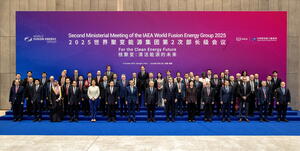A catalyst at a critical juncture
Established by the International Atomic Energy Agency (IAEA) in 2024, the World Fusion Energy Group seeks to promote the advancement of a “transformative technology.”
The Second Ministerial Meeting of the World Fusion Energy Group opened jointly with the 30th IAEA Fusion Energy Conference in Chengdu, China, on 14 October 2025.
Speaking to a large assembly of leaders, scientists and policy makers, IAEA Director General Rafael Mariano Grossi described the Group as a unique global platform where all actors—from governments and regulators to research institutions and private industry—come together around concrete topics and implementation.
Among the areas of focus, supporting the establishment of effective fusion regulation, fostering international collaboration through dialogue and partnership, identifying technology and engineering gaps, and promoting public engagement were cited during the group’s inaugural meeting in 2024 and emphasized again this year.
Achieving the goal of supporting fusion R&D and deployment will require an “inclusive, multistakeholder approach,” said China’s Vice Premier Guoqing Zhang, in his address to the Ministerial Meeting. “Equally vital is building public trust: engaging communities from the very beginning to ensure that fusion energy is developed transparently, deployed safely, and embraced responsibly.”
ITER Director-General Pietro Barabaschi used his address to the body to list the ways in which the ITER project is delivering value to the global effort toward fusion energy—training the next generation of fusion engineers, technicians, and scientists; creating a global fusion supply chain; and opening ITER’s doors to the private sector. He also evoked the significant challenges that remain.
“Fusion energy’s promise is real, but so are its challenges,” he said, as he listed cost, power flux/materials, tritium breeding and RAMI (reliability, availability, maintainability and inspectability) as substantial hurdles that remain to be resolved. “Our shared success will come from thoughtful collaboration, innovation and collective perseverance.”
The IAEA plans to periodically convene World Fusion Energy Group gatherings to review achievements, maintain high-level engagement, and promote further collaborative action.
See the Statement published after the Second Ministerial Meeting here.


